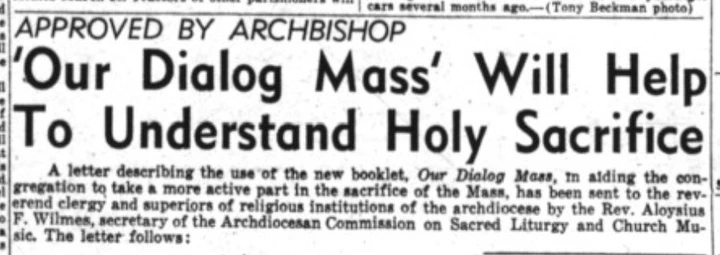Father Joseph Byron and Dialogue Homilies
 The St. Louis Review, Volume 9, Number 14, 1 April 1949
The St. Louis Review, Volume 9, Number 14, 1 April 1949Father Joseph Byron came to my attention because of his connection to a minor innovation, “dialogue homilies.” It is difficult to say with certainty what they were, but judging by results in the Catholic News Archive, they were an experimental feature of some liturgies practiced in 1966-1972.
There is an oblique description of dialogue homilies in 1968:
Nor have the dialogue homilies been the sort Msgr. Oesterreicher mentions with disdain. The people I’ve heard were sharing insights - often marvelously deep drawn from the Scripture readings. and if they mentioned their own experiences they did it In the context of witnessing to the action of the Spirit in their lives and in Ihe world.1
They are frequently mentioned alongside other somewhat new liturgical experiments, such as Communion in both species and spontaneous Prayers of the Faithful.
Their life was short lived, as evidenced by questions Fr. David Q. Liptak fielded in 19712 and 19763.
Ordained in 1953, Father Joseph F. Byron of the Archdiocese of Washington was experimenting with “dialogue homilies” shortly after the Second Vatican Council. He became famous for something else entirely - dissent from Pope Paul VI’s encyclical Humanae Vitae.
Following Vatican II (1962-1965), Byron was encouraged by anticipated liturgical changes to experiment with the liturgy and incorporated guitar music and “dialogue homilies” into his liturgies at the Newman Center at American University. These changes were considered inappropriate by Archbishop (and soon Cardinal) O’Boyle and were feared to cause confusion among the faithful. But there were greater issues coming out from Vatican II and its interpretation that brought Byron and other area priests into conflict with O’Boyle. Following the promulgation of Paul VI’s encyclical Humanae Vitae, on July 26, 1968, Byron was among 40 signers of the Statement of Conscience, which expressed concern over issues surrounding artificial birth control. Some signers disagreed with the encyclical’s upholding of the Catholic Church’s condemnation of the practice. Others, though agreeing with its conclusions, differed on how to deal with the issue pastorally, particularly as it affected confession and reception of the sacraments. As a result of the Statement of Conscience, Byron and the other signers were suspended from priestly ministry to varying degrees by Cardinal O’Boyle.
Byron was one of 19 priests who disputed their suspension and he undertook to have their case brought before the Church judicially. Byron was given permission by mandates signed by the other priests to act in their names, and with the advocacy of an association of American priests called the National Federation of Priests’ Councils, and its Committee of Concerned Canon Lawyers (CCCL), he eventually petitioned Pope Paul VI after it was determined that neither the Washington nor Cleveland Tribunal could arbitrate the case. Paul VI gave the Congregation for the Clergy the task of hearing the case and rendering a decision. After drawing together information from interviews with the priests and meeting with proxies (including Byron) and representatives of O’Boyle, the Congregation reached a decision based on their findings. It was determined that O’Boyle had followed the requirements of the Code of Canon Law, and the priests’ representatives were able to clarify their position on the authority of the magisterium, conscience, and pastoral practice in a statement that was acceptable by them and the Congregation. Eventually the priests who still sought to resume their duties, by endorsing the findings, were able to do so.4
Fr. Byron and “The Case of the Washington Nineteen” was covered by the Washington Post, in no small part because of the surprising appeal granted to Byron.
After much backing and filling, in a surprising move, Cardinal Villot, the Vatican secretary of state, informed Father Byron that the matter had been turned over to the Sacred Congregation for the Clergy, whose prefect then was Cardinal John Wright, formerly bishop of Pittsburgh.
Cardinal Wright then devised a procedure whereby counsel presented appropriate documents, questions were propounded and two weeks of hearings were held in Rome. In due course, the congregation made a final evaluation and issued a finding that was delivered to Father Byron in April 1971. The finding included seven statements of doctrine in a form that the dissenting priests were happy to accept. Cardinal O’Boyle subsequently concurred with the formulation of the congregation and thereupon restored their faculties to the petitioners.5
Cardinal Wright’s involvement, especially as the creator of a potentially new canonical process that allowed dissident priests to return to ministry, is notable.
Wright was one of the most high-ranking prelates of his day. Less impressively, an entire chapter is dedicated to Wright’s alleged homosexuality in Engel’s The Rite of Sodomy.6. Wright was specifically named in a lawsuit in 2004, alleging that he protected abusive clerics.7
Wright’s secretary was Archbishop Donald Wuerl, who at this point needs no introduction.8
Sources
The Catholic Advocate, Volume 17, Number 27, 27 June 1968. https://thecatholicnewsarchive.org/?a=d&d=ca19680627-01.2.55&srpos=12 ↩︎
The Catholic Transcript, Volume LXXIV, Number 37, 31 December 1971. https://thecatholicnewsarchive.org/?a=d&d=CTR19711231-01.2.26&srpos=23 ↩︎
The Catholic Transcript, Volume LXXI, Number 3, 26 May 1978. https://thecatholicnewsarchive.org/?a=d&d=CTR19780526-01.2.29&srpos=30 ↩︎
Joseph F. Byron. The American Catholic Research Center and University Archives. https://libraries.catholic.edu/special-collections/archives/collections/finding-aids/finding-aids.html?file=byron ↩︎
John S. Monaghan, “Father Byron’s Courage,” Washington Post, August 27, 1992. https://www.washingtonpost.com/archive/opinions/1992/08/27/father-byrons-courage/89b6c226-cd24-44de-93bc-db649f063d92/?fbclid=IwAR0urMbGV5naEiAf84bJVD6t9JmSSLZOgx60wiyEf8r3C13_uQuVB3mi7N4 ↩︎
Randy Engels, The Rite of Sodomy: Homosexuality and the Roman Catholic Church, (New Engel Publishing, 2011). ↩︎
Sharon Roulier and Father Bill Pomerleau, “Inmate Files Lawsuit against Two Dioceses,” Catholic Observer, March 31, 2005. http://www.bishop-accountability.org/news3/2004_06_29_Shaw_PriestBishops_Brendan_ODonoghue_6.htm ↩︎
George Neumayr, “What Begins in Bad Theology Ends in Police Raids,” The American Spectator, December 2, 2018. https://spectator.org/what-begins-in-bad-theology-ends-in-police-raids/ ↩︎